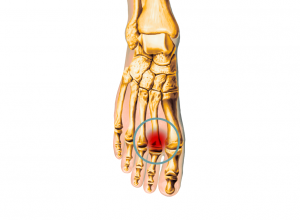
Capsulitis
Capsulitis, also called pre-dislocation syndrome, is a condition in which certain joint capsules (ligaments) become inflamed. It most often affects the shoulder and the metatarsal joint of the second toe and can lead to shoulder or toe dislocation if not treated appropriately.
Causes
Foot capsulitis can affect any of the capsules surrounding the metatarsophalangeal (MTP) joints at the ball of your foot, but it most often affects the joint of the second toe. Experts disagree on what exactly causes capsulitis but abnormal foot mechanics are usually to blame, with the explanation being that the ball of the foot takes more weight-bearing pressure than it is designed for, which ultimately irritates the capsule-like ligaments meant to protect the joints.
Some foot abnormalities that can lead to capsulitis include bunions, abnormal gait, a long second toe, arch problems and continuous wear of high-heeled shoes. In fact, wearing heeled footwear and shoes with tapered toe boxes significantly increase your chance of developing capsulitis, as these types of shoes force the toes into unnatural positions and ultimately change the way the ball of your foot and toes absorb pressure.
Symptoms
Early symptoms of capsulitis include pain in the ball of the foot, swelling in the plantar area of the foot and/or near the second toe, a shooting sensation in the bottom of the foot that feels like stepping on a marble and difficulty wearing shoes.
Capsulitis progresses quickly. If left untreated, the ligaments in the bottom of the foot will break down and could cause the unstable second toe to drift over and lay on top of the big toe. This causes additional pain and swelling, and it increases your risk of developing bursitis as well as painful corns (often confused as plantar warts) and calluses.
Treatment
Because capsulitis quickly worsens without treatment, it’s important to seek medical attention early on. If the condition is caught before the second toe begins to move and cross on top of the big toe, non-surgical approaches are often used to stabilize the joint. These include taping and splinting the toe, foot and toe stretches to increase muscle and joint strength, supportive shoes with stiff soles or orthotic devices containing metatarsal pads, oral medications to help with the pain, rest, and ice to help with any possible swelling.
If capsulitis progresses to the point where the second toe begins to move toward to the big toe, the foot will remain deformed unless surgery is performed. An orthopaedic surgeon or foot and ankle surgeon will decide which type of surgery is best depending on each individual case.
Notice concerning medical entries:
Articles having medical content shall serve exclusively for the purpose of general information. Such articles are not suitable for any (self-) diagnosis and treatment of individual illnesses and medical indications. In particular, they cannot substitute for the examination, advice, or treatment by a licensed physician or pharmacist. No replies to any individual questions shall be effected through the articles.






